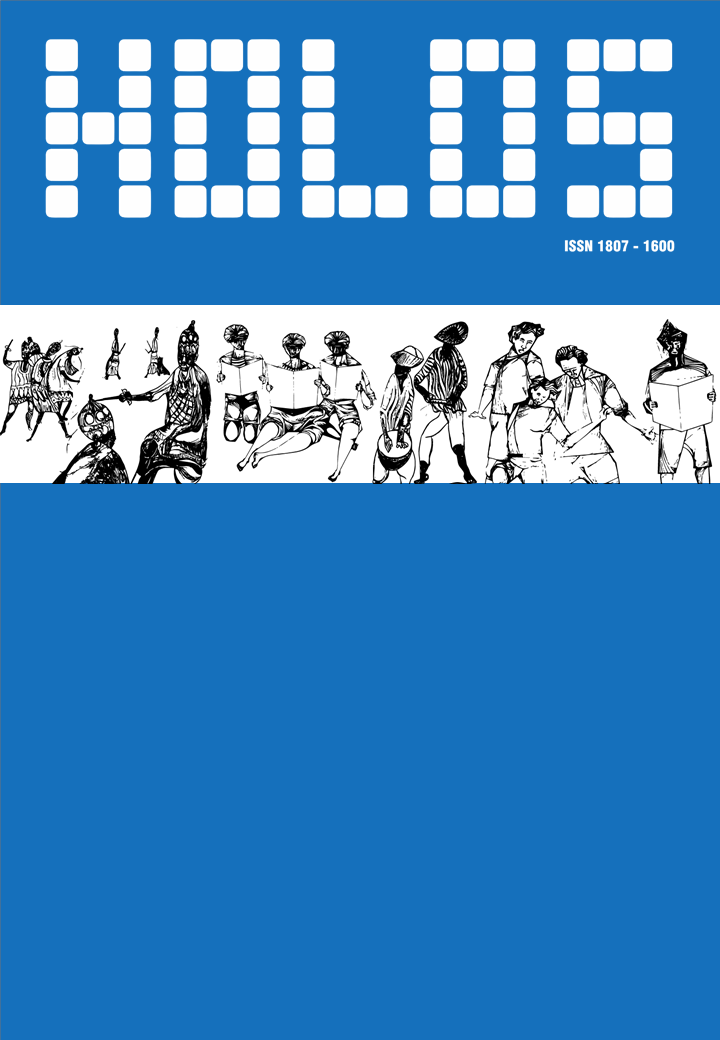PERFILAGEM ELÉTRICA DE DESAGUAMENTO DE AREIA INDUZIDO POR VIBRAÇÃO
DOI:
https://doi.org/10.15628/holos.2020.8952Palavras-chave:
desaguamento, eletrorresistividade, arranjo Wenner alfa, análise de sensibilidade, dewatering, electroresistivity, moisture, Wenner alpha array, sensitivity analysis.Resumo
Resumo: A perfilagem eletrorresistiva da umidade no leito de areia quartzosa sobre tela vibratória em escala piloto foi tratado aqui. No que tange à configuração do eletrodos para medição de eletrorresistividade, o arranjo Wenner alfa clássico foi usado, exigindo espaçamento igual entre os eletrodos e mesma profundidade de penetração e alinhamento corretos. Aqui, a influência de pequenas variações na profundidade de penetração e falta de colinearidade dos eletrodos nas leituras de umidade, usando um eletrorresistivímetro digital e eletrodos de cobre, foi avaliada. As profundidades de penetração estudadas foram de 50 mm e 55 mm. Por sua vez, o desalinhamento testado dos eletrodos foi de 10 mm. O único fator que causou efeito estatisticamente significativo nas medições foi a profundidade de penetração de eletrodo, ao menos na faixa aqui estudada.
Title: ELECTRICAL PROFILING OF VIBRATION-INDUCED DEWATERING OF SAND
Abstract: Electrorresistive profiling of moisture inside a quartz sand bed on a pilot-scale vibrating screen was treated here. As electrode or probe configuration for resistivity measurement is concerned, the classical Wenner ? array was used, requiring equal electrode spacing, and correct penetration depth and alignment. Here, the influence of small variations in penetration depth and lack of probe collinearity on the moisture readings, using a digital earth resistance tester and copper wires as probes, was evaluated. The penetration depths studied were 50 mm and 55 mm. In turn, the electrode misalignment tested was 10 mm. The only factor that has caused a statistically significant effect in measurements was probe penetration depth, at least under the range tested here.
Downloads
Referências
Bristow, K. L. et al. (2001, May). A small multi-needle probe for measuring soil thermal properties, water content and electrical conductivity. Computers and Electronics in Agriculture, 31(3), 265–280. doi: 10.1016/S0168-1699(00)00186-1 DOI: https://doi.org/10.1016/S0168-1699(00)00186-1
Bui, Ph. T., Ogawa, Y., Nakarai, K., & Kawai, K. (2016, June) . Electrical resistance measurement to assess moisture transfer in cement-based mortar through water absorbing and drying processes. Proceedings of The Japan Concrete Institute, 38(1), 813–818.
Dahlin, T. & Loke, M. (1998, February). Resolution of 2D Wenner resistivity imaging as assessed by numerical modelling. Journal of Applied Geophysics, 38(4) 237–249. doi: 10.1016/S0926-9851(97)00030-X DOI: https://doi.org/10.1016/S0926-9851(97)00030-X
Ding, J., & Chandra, R. (2018, October 7). Estimating soil moisture and electrical conductivity using Wi-Fi. Microsoft Research. https://www.microsoft.com/en-us/research/uploads/prod/2018/10/SMURF_TR-1.pdf .
Glover, P. W. J. (2010, April). The discovery of an anglo-saxon grubenhaus at new bewick, northern UK using electrical surveying and predictive deconvolution. Archaeometry, 52(2), 320–342. doi: 10.1111/j.1475-4754.2009.00468.x DOI: https://doi.org/10.1111/j.1475-4754.2009.00468.x
Jolly (née moore), J. M., Beaven, R. P. and Barker, R. D. (2011, May). Resolution of electrical imaging of fluid movement in landfills. Proceedings of the Institution of Civil Engineers - Waste and Resource Management, 164(2), 79-96. doi: 10.1680/warm.2011.164.2.79 DOI: https://doi.org/10.1680/warm.2011.164.2.79
Lasfargues, P. (1957). Prospection électrique par courants continus. Masson & Cie.
Luz, J. A. M. & Santana, D. C. (1992). Monitoramento de umidade em sinter feed por eletrorresistividade (Internal Report No. 1). Tecnomin — Projeto e Consultoria Ltda.
Morris, W., Moreno, E. I. & Sagüés, A. A. (1996, December). Practical evaluation of resistivity of concrete in test cylinders using a Wenner array probe. Cement and Concrete Research, 26(12), 1779–1787. doi: 10.1016/S0008-8846(96)00175-5 DOI: https://doi.org/10.1016/S0008-8846(96)00175-5
Neyamadpour, A., Wan Abdullah, W. A. T. & Taib, S. (2010, May). Use of four-electrode arrays in three-dimensional electrical resistivity imaging survey. Studia Geophysica et Geodaetica, 54(2), 299–311. doi: 10.1007/s11200-010-0016-8 DOI: https://doi.org/10.1007/s11200-010-0016-8
Olayinka, A. I. & Yaramanci, U. (2000, September). Use of block inversion in the 2-D interpretation of apparent resistivity data and its comparison with smooth inversion. Journal of Applied Geophysics, 45(2) 63–81. doi: 10.1016/S0926-9851(00)00019-7 DOI: https://doi.org/10.1016/S0926-9851(00)00019-7
Pandey, L. M. S., Shukla, S. K., & Habibi, D. (2015, August). Electrical resistivity of sandy soil. Géotechnique Letters 5(3): 178-185. doi: 10.1680/jgele.15.00066 DOI: https://doi.org/10.1680/jgele.15.00066
Pinto, E. (2005). Melhoria e medição de terras: Medição da resistividade do solo: Método de Wenner. Universidade do Porto.
Roodpsoshti, H. R., Hafizi, M. K., Kermani, M. R. S., & Nik, M. R. G. (2019, September). Electrical resistivity method for water content and compaction evaluation, a laboratory test on construction material. Journal of Applied Geophysics, 168, 49–58. doi: 10.1016/j.jappgeo.2019.05.015 DOI: https://doi.org/10.1016/j.jappgeo.2019.05.015
Spiridonov, V. P. & Lopatkin, A. A. (1973). Tratamiento matemático de datos físico-químicos. Editorial Mir.
Thabit, J. M. & Khalid, F. H. (2015, December). Resistivity imaging survey to delineate subsurface seepage of hydrocarbon contaminated water at Karbala Governorate, Iraq. Environmental Earth Sciences, 75(1), 1–7. doi: 10.1007/s12665-015-4880-y DOI: https://doi.org/10.1007/s12665-015-4880-y
Valente, A. et al. (2006, November). Multi-functional probe for small-scale simultaneous measurements of soil thermal properties, water content, and electrical conductivity. Sensors and Actuators A: Physical, 132(1), 70–77. doi: 10.1016/j.sna.2006.05.010 DOI: https://doi.org/10.1016/j.sna.2006.05.010
Wenner, F. (1915, October). A method for measuring Earth resistivity. Journal of the Washington Academy of Sciences, 5(16), 561-563.
Wills, B. A. & Napier-Munn, T. (2006). Mineral processing technology: An introduction to the practical aspects of ore treatment and mineral recovery. Elsevier Sciente & Technology Books. DOI: https://doi.org/10.1016/B978-075064450-1/50003-5
Wolfram Alpha. (2016, September 17). Computational knowledge engine. https://www.wolframalpha.com/input/?i=derivative.









































